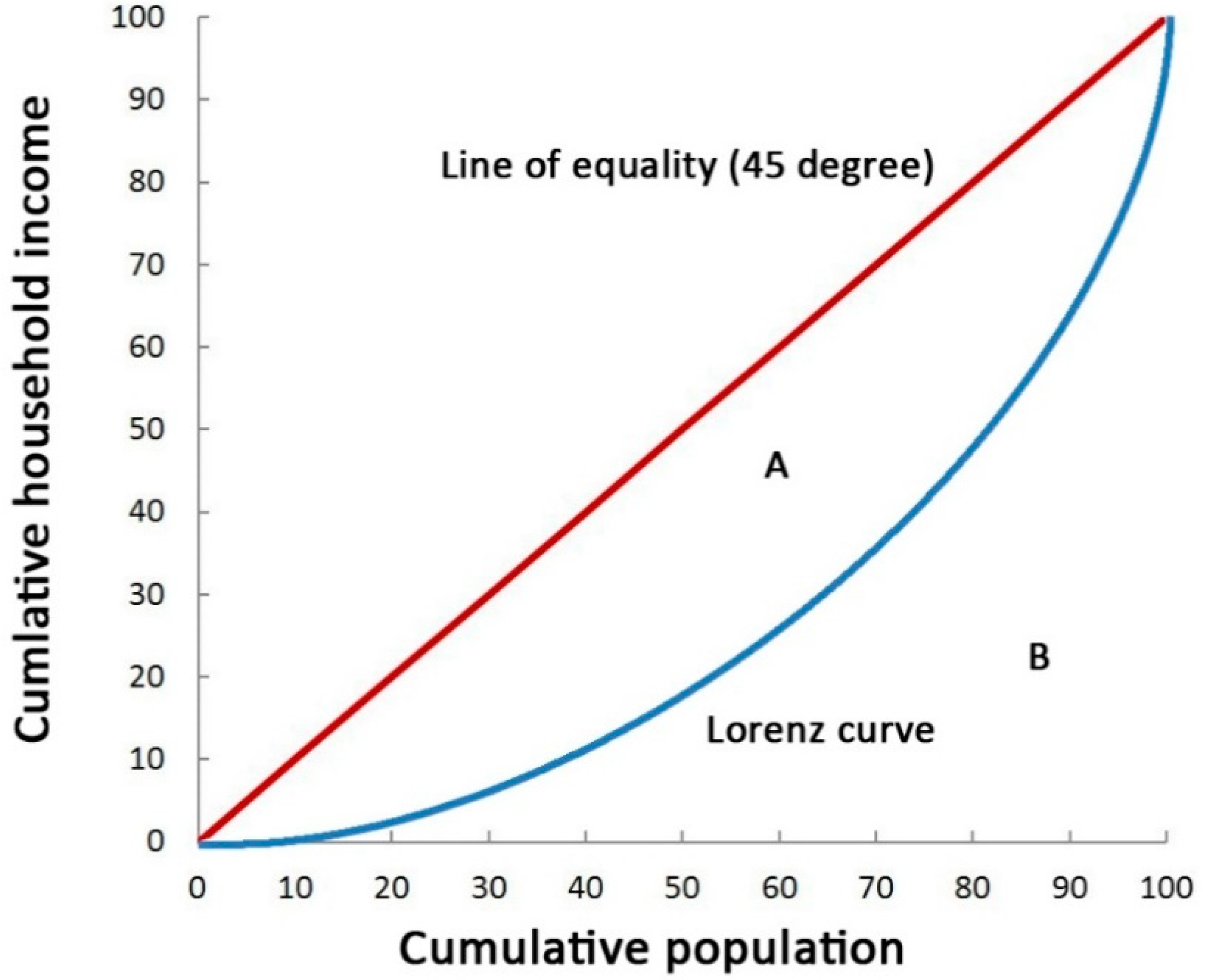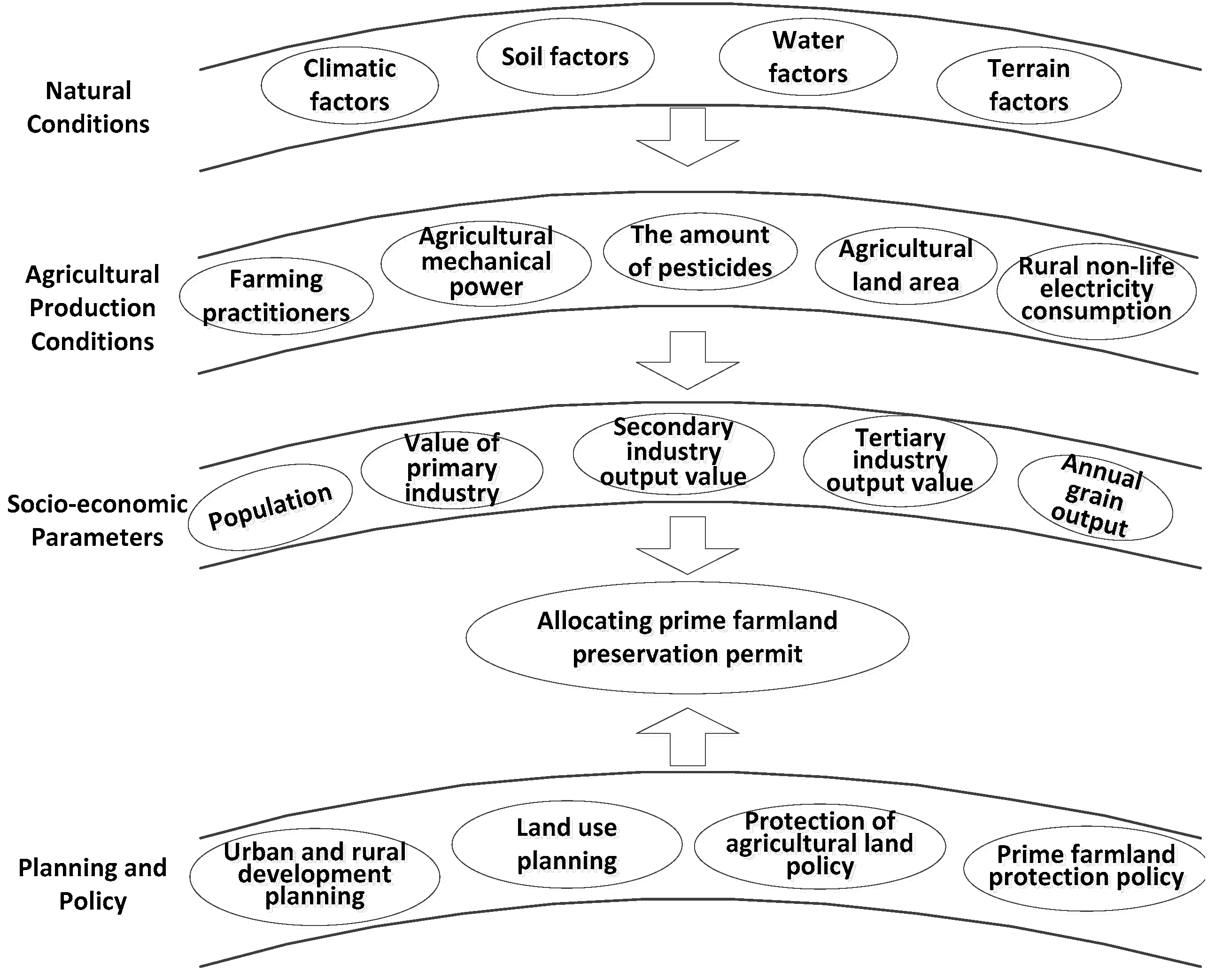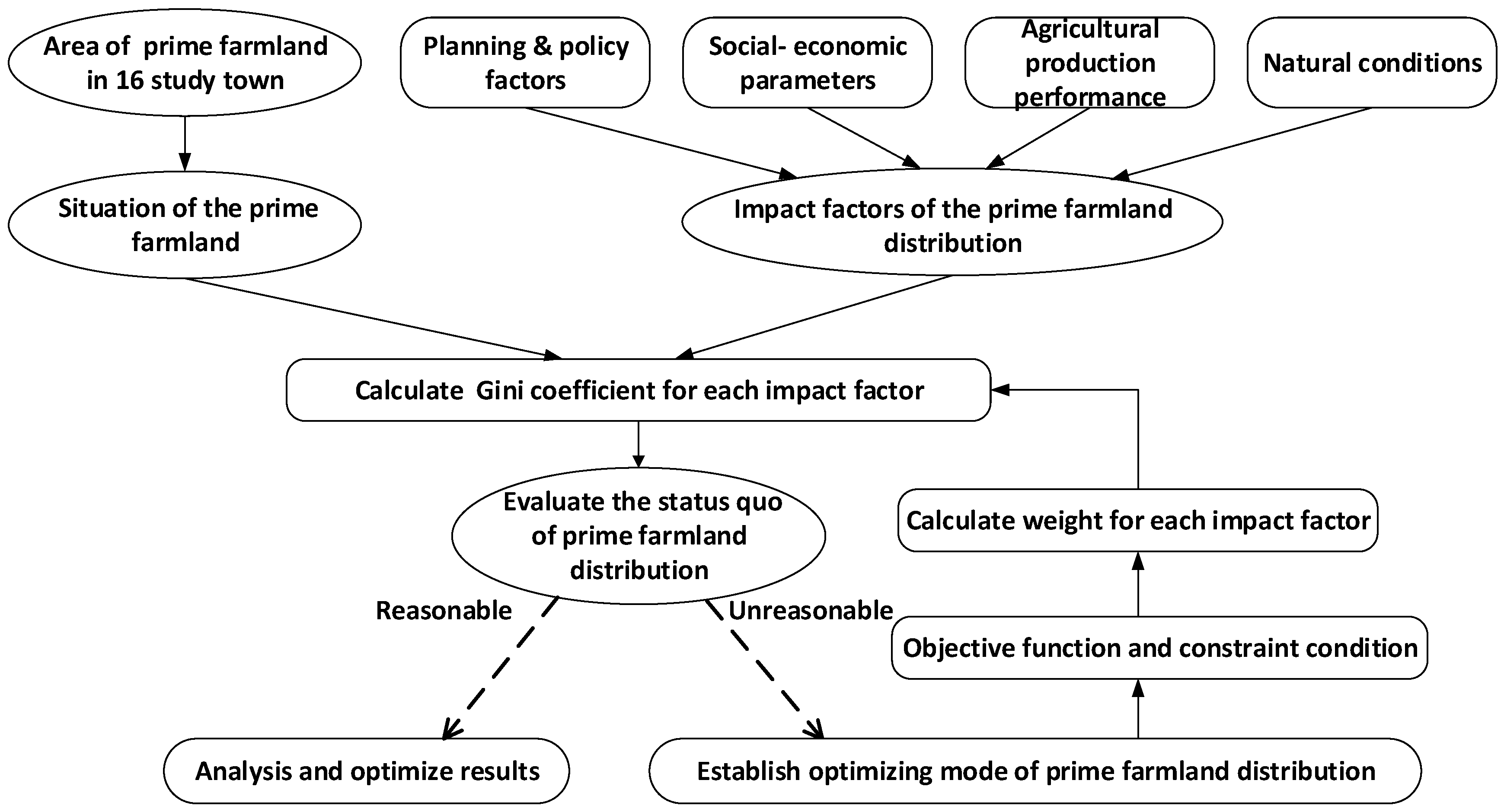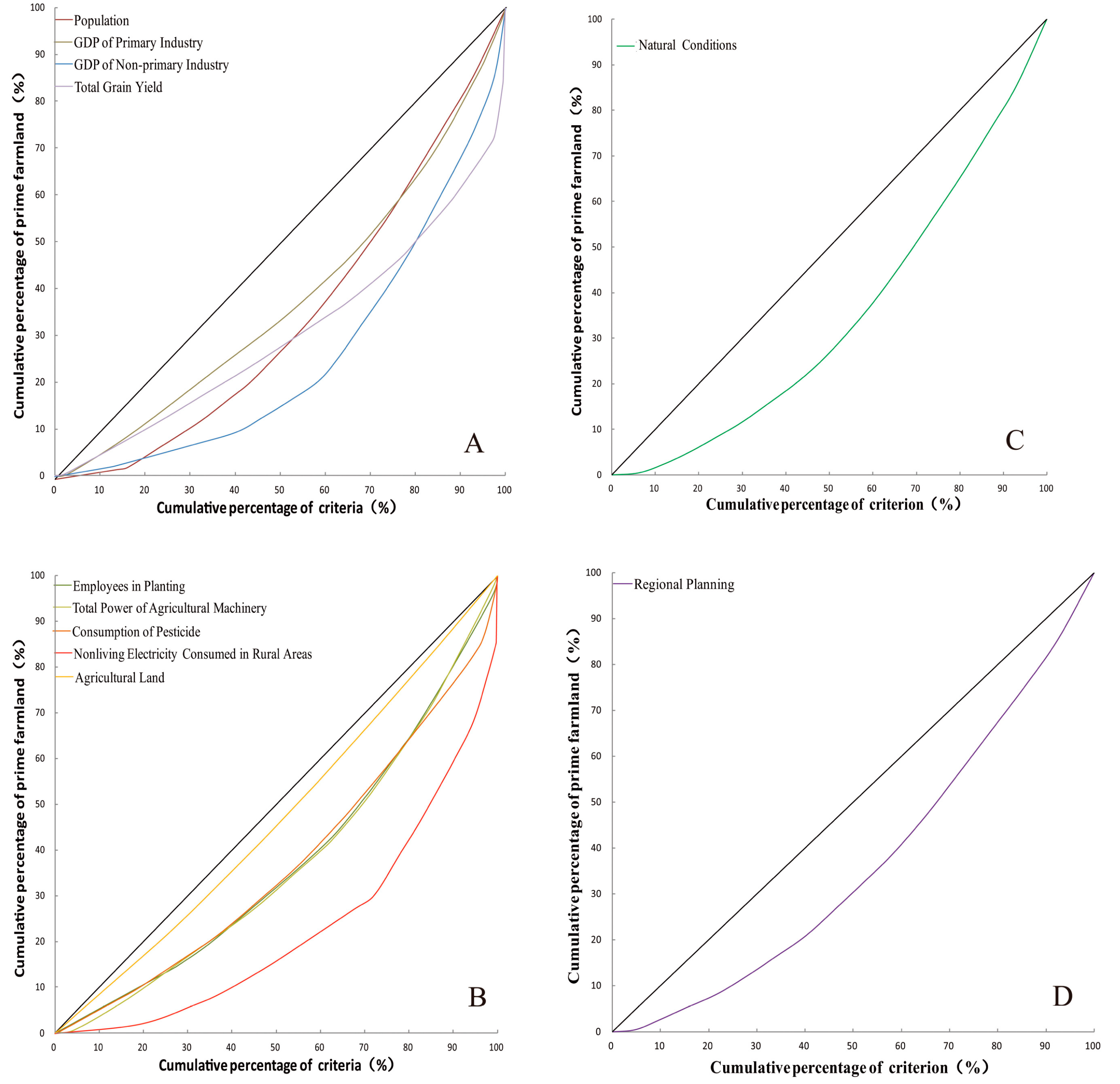Optimization Model of Permanent Basic Farmland Indicators Distribution from the Perspective of Equity: A Case from W County, China
Abstract
:1. Introduction
2. Literature Review
3. Study Area
4. Methodology
4.1. Gini Coefficient Method
4.2. Coefficient of Variation Method
4.3. Hierarchical Structure of the Impact Factors
- (1)
- Factors of natural conditions: permanent basic farmland indicator distribution was greatly affected by natural conditions; climate, topography, soil and water-use conditions were necessary. The agricultural land classification and gradation had been quickly calculated based on the above natural conditions data. The quality of agricultural land in W county was classified with the grading. Meanwhile, the grading score was published and renewed regularly. In this analysis, the achievements of agricultural land classification in 2018 would be taken into account. The grading scores in 16 research units were represented as composite factors of natural conditions.
- (2)
- Factors of agricultural production conditions: Factors such as farming practitioners, power of agricultural machinery, consumption of pesticide, family labor and nonliving electricity affected the efficiency of farmland production. Most factors of agricultural production conditions were considered in this analysis.
- (3)
- Factors of social and economic conditions: Factors in this level include many external conditions affecting farmland production and protection. The population of secondary and tertiary industry (the population in Table 1) represented the development degree of labor markets which was also an indirect source of labor and consumption capacity of agricultural products in each town. Similarly, the GDP factor has been divided into two evaluation factors: the primary industry value and the non-primary industry value. The output value of primary industry and annual grain yield have shown the agricultural productive capacity in each research unit. The output value of secondary and tertiary industry represents the development degree of the industrial economy, which can provide equipment guarantee and technological innovation for agricultural production. It was also the basis to measure the modernization degree of agricultural production in towns.
- (4)
- Planning and policy factors: The agricultural development policy of local administration, forces of urbanization and the planning of urban-suburban land use were all included in this group. In addition to land use planning indicators, the quantitative indicators of policy factors mainly included the last round of farmland protection indicators and the number of consolidation and reclamation projects, which should serve as an important potential source of permanent basic farmland. It was also the embodiment of the agricultural development policies of towns in terms of indicators.
4.4. Allocation Steps
4.5. Constraints and Calculations
- (1)
- In order to ensure the fairness of the permanent basic farmland layout, the Gini coefficient after the optimization should be no bigger than G0j. The Gini coefficient after the optimization should be smaller than the warning value of 0.4. This warning value had been regarded as the segmentation line of the fair distribution [24].
- (2)
- Referring to the practice of balance between occupation and compensation of local cultivated land, the land type composition of permanent basic farmland consists of two processes: static demarcation and dynamic compensation. At present, a new round of demarcation of “three districts and three lines” in China is being carried out. Due to the limitation of data sources, this study adopted the classification standard of the second land resources survey. The lower limit (y0i) of the permanent basic farmland preservation indicator in each research unit was 0.8 times of the current farmland area. Meanwhile, the upper limit (yui) of the permanent basic farmland area was the sum of the existing farmland area and 0.5 times of the garden plot.
- (3)
- According to the permanent basic farmland protection planning of W county, the total area of permanent basic farmland in the research zone will reach 40,803 hm2 in 2025. Therefore, this study takes this value as the final binding condition.
5. Result
5.1. Lorenz Curve Based on Each Assessment Index
5.2. Final Allocations after Optimizing
6. Discussion
6.1. Gini Coefficient of Final Allocation
- (1)
- After optimization, Table 1 shows that the gross Gini coefficient had decreased from 0.318 to 0.298. Meanwhile, all the Gini coefficients of the impact factors were lower than the warning value of 0.4 after the optimization, which showed that the optimization program was reasonable.
- (2)
- The Gini coefficient of all indicators was not lower than the warning value, which related to the existing amount of cultivated land and the allowable increase or decrease in each town. If these factors were not taken into account, radical fair schemes would be of great harm to economic development and social management. On the other hand, this was related to the objective function of the optimization model, which only required the weighted sum of Gini coefficients of all indexes to be minimum, but did not require that Gini coefficients of all indexes be lower than the warning value. Therefore, this scheme was to obtain the optimal solution under the constraint conditions. On the premise of fairness, the index allocation was more operational than before. Because the central government still had a minimum quantity limit for the management of permanent basic farmland, it was not required that every parameter be lower than the warning value to pursue ultimate fairness such as in other studies [30].
- (3)
- To some extent, the lower Gini coefficients of agriculture land represented the weaker influence of agriculture land on the allocation of permanent basic farmland. On the contrary, the influence of some factors had not declined although the coefficient is reduced. Most weights of agricultural production conditions factors were larger, such as farming practitioners, power of agricultural machinery, consumption of pesticide, family labor and nonliving electricity. Those factors affected the efficiency of farmland production. Therefore, the impact of production efficiency on cultivated land protection should play a greater and greater role. Thus, changing the original only considers farmland itself as a single factor, which is consistent with the view of Zhang et al. [31]. With this hierarchical structure model, we could grasp such mechanism of effects adequately.
- (4)
- Indicator weight setting is the key to solving a multi-objective optimization problem. However, the selection of indicator weights still has a certain degree of subjectivity in some of the relevant literature [32,33]. In this study, the objective weight of each index had been set according to the coefficient of variation method, all of which makes the result more reasonable, avoiding the difference in subjective scoring results.
6.2. Analysis of Allocation Results
- (1)
- The permanent basic farmland drastically decreasing areas include Huangli, Zouqu, Henlin and Jiaze town. From Figure 1, we can see that these areas were mostly located in the northwest of the research area. These towns have thousands of years of continuous agricultural product history. Although the permanent basic farmland area occupied a prodigious proportion in W county, the traditional competition had been fading away. The secondary and tertiary industry lagged behind other towns. The agricultural production efficiency was at lower levels in the whole county. Hence, the primary production of this area covered a relatively small portion of the total production. As a result, it was necessary to reduce the indicator of permanent basic farmland and improve the efficiency of land use [35,36].
- (2)
- The permanent basic farmland slightly decreasing areas includes Hutang and Benniu town. The slightly increasing permanent basic farmland area includes Yaoguan, Nanxiashu, Lijia, Hengshanqiao, Zhenglu and Niutang town. These towns had a very high proportion of industrial production whereas the agricultural economy accounts for a very low proportion. Leading talent and technology advantage should be responsible for more indicators than the status quo for agriculture products and protection.
- (3)
- The indicator in towns such as Luoyang, Xihu and Xueyan town had drastically increased. The changing indicator among these towns results from the huge potency in permanent basic farmland preservation. Conversion of farmland to forests whose top priority was ecology protection had been successful after 10 years of implementation. Conversion of farmland to forests shall be combined with the restructuring of rural industries, development of rural economy conservation and development of capital farmland, increase of per unit area yield, enhancement of rural energy development and eco-driven immigration.
7. Conclusions
Author Contributions
Funding
Informed Consent Statement
Data Availability Statement
Acknowledgments
Conflicts of Interest
References
- Piana, P.; Faccini, F.; Luino, F.; Paliaga, G.; Sacchini, A.; Watkins, C. Geomorphological Landscape Research and Flood Management in a Heavily Modified Tyrrhenian Catchment. Sustainability 2019, 11, 4594. [Google Scholar] [CrossRef]
- Viciani, D.; Dell’Olmo, L.; Gabellini, A.; Gigante, D.; Lastrucci, L. Landscape dynamics of Mediterranean montane grasslands over 60 years and implications for habitats conservation. A case study in the northern Apennines (Italy). Landsc. Res. 2018, 43, 952–964. [Google Scholar] [CrossRef]
- Wang, C.; Liang, L.; Gao, F. Enlightenment of foreign agricultural land protection policies and measures to China. Sci. Technol. Manag. Land Resour. 2007, 24, 61–64. (In Chinese) [Google Scholar]
- Robinson, R.A.; Sutherland, W.J. Post war changes in arable farming and biodiversity in Great Britain. J. Appl. Ecol. 2002, 39, 157–176. [Google Scholar] [CrossRef]
- Aizaki, H.; Sato, K.; Osari, H. Contingent valuation approach in measuring the multifunctionality of agriculture and rural areas in Japan. Paddy Water Environ. 2006, 4, 217–222. [Google Scholar] [CrossRef]
- Wang, S. Viewing the Chinese logic of food security from the white paper of China’s food security. China’s Grain Econ. 2019, 44, 5–7. (In Chinese) [Google Scholar]
- Zhang, Y. Research on China’s Basic Farmland Protection System; Northwest A&F University: Xianyang, China, 2013. (In Chinese) [Google Scholar]
- Hong, S.; O’Sullivan, D. Detecting ethnic residential clusters using an optimization clustering method. Int. J. Geogr. Inf. Sci. 2012, 26, 1457–1477. [Google Scholar] [CrossRef]
- Nelson, A.C. Preserving permanent basic farmland in the face of urbanization: Lessons from Oregon. J. Am. Plan. Assoc. 1992, 58, 467–488. [Google Scholar] [CrossRef]
- Wang, H.; Li, W.; Huang, W.; Nie, K. A Multi-Objective Permanent Basic Farmland Delineation Model Based on Hybrid Particle Swarm Optimization. ISPRS Int. J. Geo-Inf. 2020, 9, 243. [Google Scholar] [CrossRef]
- The Central People’s Government of the People’s Republic of China. Notice of the General Office of the Ministry of Land and Resources on Launching a New Round of Pilot Work of General Land Use Planning. Available online: http://www.gov.cn/xinwen/2018-01/16/content_5257103.htm (accessed on 16 January 2018).
- Jayne, T.S.; Yamano, T.; Weber, M.T.; Tschirley, D.; Rui, B.F.; Chapoto, A.; Zulu, B. Smallholder income and land distribution in Africa: Implications for poverty reduction strategies. Food Policy 2003, 28, 253–275. [Google Scholar] [CrossRef]
- Wu, M. Study on Permanent Basic Farmland Demarcation Based on Cultivated Land Quality Evaluation; East China Institute of Technology: Nanchang, China, 2017. (In Chinese) [Google Scholar]
- Yang, X.; Jin, X.; Jia, P.; Ren, J. Designation method and demonstration of permanent basic farmland in county level on view of multi-planning integration. Trans. Chin. Soc. Agric. Eng. 2019, 35, 250–259. (In Chinese) [Google Scholar]
- Chen, W.; Zhao, L.; Ye, M.; Wu, Z.; Luo, K. A preliminary study on the method of quantitative determination and index decomposition of provincial basic farmland. China Land Sci. 2006, 6, 45–51. (In Chinese) [Google Scholar]
- Bao, M. Study on the delineation of permanent basic farmland in Zhouzhi county, Shaanxi Province based on LESA. Agric. Technol. 2020, 5, 34–37. [Google Scholar] [CrossRef]
- Zhao, S.; Zhang, H.; Jiang, Y. Research on allocation technology of cultivated land reserve index at township level-taking Lilin Town, Jiyuan City as an example. Hubei Agric. Sci. 2012, 51, 265–267+276. (In Chinese) [Google Scholar]
- Liu, Y.; Liu, C.; He, Z. Delineation of Basic Farmland Based on Local Spatial Autocorrelation Analysis of Cultivated Land Quality in Pixel Scale. Trans. Chin. Soc. Agric. 2019, 50, 260–268. [Google Scholar] [CrossRef]
- Ren, Y.; Sun, J.; Liu, Y.; Pan, Y. Delineation Method of Permanent Basic Farmland on County Scale. Trans. Chin. Soc. Agric. Mach. 2017, 48, 135–141. (In Chinese) [Google Scholar]
- Nie, Y.; Wu, X.; He, Y. Study on the demarcation of basic farmland at county level based on productivity accounting and spatial clustering. Resour. Environ. Yangtze River Basin 2014, 23, 809–815. (In Chinese) [Google Scholar]
- Zhang, Y.; Pan, Y.; Wang, Y.; Tang, X.; Zhao, C. Study on the Selection of Cultivated Land into Basic Farmland Based on Agricultural Land Economy. Agric. Mech. Res. 2012, 26, 29–33+97. [Google Scholar] [CrossRef]
- Wang, X.; Zhang, A. Application of XGS Decision Model in Basic Farmland Delimitation—A Case Study of Shihui Town, Qianjiang District, Chongqing. Agric. Mech. Res. 2013, 35, 217–220+224. (In Chinese) [Google Scholar] [CrossRef]
- Lin, C.; Ma, Z. Study on the delineation of basic farmland in Linchong area based on CLUE-S model. Surv. Mapp. Spat. Geogr. Inf. 2014, 37, 25–29. (In Chinese) [Google Scholar]
- Qian, F.; Wang, Q. Basic farmland demarcation based on agricultural land classification and LESA method. Soil Water Conserv. Res. 2011, 18, 251–255. (In Chinese) [Google Scholar]
- Almasa, I.; Cappelena, A.W.; Lindb, J.B.; Sørensen, E.Ø.; Tungodden, B. Measuring unfair (in)equality. J. Public Econ. 2011, 95, 488–499. [Google Scholar] [CrossRef]
- Luo, W.Y.; Chen, J.; Fu, H.C. Equality index: From Gini coefficient to income-satisfaction. Contemp. Financ. Econ. 2017, 11, 5–10. [Google Scholar]
- Changzhou Statistics Bureau. Changzhou Statistical Yearbook. Available online: http://tjj.changzhou.gov.cn (accessed on 1 January 2019).
- Piet, L.; Latruffe, L.; Le Mouel, C.; Desjeux, Y. How do agricultural policies influence farm size inequality? The example of France. Eur. Rev. Agric. Econ. 2012, 39, 5–28. [Google Scholar] [CrossRef]
- Masaki, Y.; Hanasaki, N.; Takahashi, K.; Hijioka, Y. Global-scale analysis on future changes in flow regimes using Gini and Lorenz asymmetry coeffcients. Water Resour. Res. 2014, 50, 4054–4078. [Google Scholar] [CrossRef]
- Xu, J. Study on Target Reductions Allocation Model of the River Based on the AHP and the Gini Coeffcient Interactive Feedback; Huazhong University of Science and Technology: Wuhan, China, 2013. (In Chinese) [Google Scholar]
- Zhang, L.; Chen, Y.; Zhang, Q.; Ye, X.; Zhang, Y. Optimization model of cultivated land allocation based on Gini coefficient. Econ. Geogr. 2012, 32, 132–137. [Google Scholar] [CrossRef]
- Sukcharoen, T.; Weng, J.; Charoenkalunyuta, T. GIS-Based Flood Risk Model Evaluated by Fuzzy Analytic Hierarchy Process (FAHP). In Proceedings of the Remote Sensing for Agriculture, Ecosystems, and Hydrology XVIII, Bellingham, WA, USA, 25 October 2016. [Google Scholar]
- Negahban, A. Optimizing consistency improvement of positive reciprocal matrices with implications for Monte Carlo Analytic Hierarchy Process. Comput. Ind. Eng. 2018, 124, 113–124. [Google Scholar] [CrossRef]
- Shen, J.; Li, L.; Zhang, K.; Sun, F.; Zhang, D. Initial allocation of water discharge right based on chaos optimization-projection pursuit. Resour. Ind. 2019, 21, 39–47. [Google Scholar]
- Zhao, X.; Zhong, D.; Yu, Q. Application of Gini coefficient method in global carbon emission rights allocation. Environ. Sci. Technol. 2015, 38, 195–204. (In Chinese) [Google Scholar]
- Xu, R. Research on the Prediction of Cultivated Land Quantity Based on Multi-Objective Programming Optimization Model-Taking Guichi District, Chizhou City, Anhui Province as an Example; Huazhong Normal University: Wuhan, China, 2011. [Google Scholar]
- Sustainable Development Strategy Research Group of Chinese Academy of Science. Strategic Report: China’s Sustainable Development; Science Press: Beijing, China, 2005. [Google Scholar]
- Tolga, T.; Erkan, R. Measuring technical efficiency and total factor productivity in agriculture: The case of the south Marmara region of Turkey. N. Z. J. Agric. Res. 2006, 49, 137–145. [Google Scholar]





| Index | Gini Coefficients | Weight of Parameter | ||
|---|---|---|---|---|
| Before Optimization | After Optimization | Decrease Proportion (%) | ||
| Population | 0.31 | 0.279 | 10.135 | 0.057 |
| Value of primary industry | 0.246 | 0.246 | 0.000 | 0.132 |
| Value of non-primary industry | 0.486 | 0.471 | 3.110 | 0.088 |
| Employees in planting | 0.255 | 0.246 | 3.406 | 0.148 |
| Total grain yield | 0.393 | 0.348 | 11.464 | 0.132 |
| Total power of agricultural machinery | 0.265 | 0.236 | 10.889 | 0.103 |
| Consumption of pesticide | 0.259 | 0.237 | 8.290 | 0.092 |
| Nonliving electricity consumed in rural areas | 0.546 | 0.546 | 0.000 | 0.127 |
| Agriculture land | 0.062 | 0.017 | 72.597 | 0.087 |
| Natural conditions | 0.305 | 0.288 | 5.444 | 0.010 |
| Planning and policy factors | 0.266 | 0.249 | 6.327 | 0.025 |
| Gross coefficients | 0.318 | 0.298 | 6.232 | 1.000 |
| Town Area | Indicators of Permanent Basic Farmland (Units: Hectare) | |||
|---|---|---|---|---|
| Before Optimization | After Optimization | Value of Increase and Decrease | Coefficient of Increase and Decrease (%) | |
| Huangli | 4366 | 3493 | −873 | −20.00 |
| Zouqu | 3732 | 2986 | −746 | −20.00 |
| Henlin | 1372 | 1098 | −274 | −20.00 |
| Jiaze | 6117 | 5056 | −1060 | −17.34 |
| Hutang | 867 | 739 | −127 | −14.72 |
| Benniu | 2887 | 2754 | −132 | −4.59 |
| Qianhuang | 4356 | 4435 | 78 | 1.81 |
| Yaoguan | 1118 | 1146 | 28 | 2.55 |
| Nanxiashu | 1874 | 1923 | 48 | 2.59 |
| Lijia | 2751 | 2869 | 117 | 4.28 |
| Hengshanqiao | 1874 | 1954 | 80 | 4.30 |
| Zhenglu | 3638 | 3860 | 221 | 6.09 |
| Niutang | 1351 | 1439 | 88 | 6.52 |
| Luoyang | 2120 | 2358 | 237 | 11.22 |
| Xueyan | 3940 | 4429 | 488 | 12.40 |
| Xihu | 205 | 257 | 52 | 25.36 |
| Total | 42,576 | 40,803 | ||
Publisher’s Note: MDPI stays neutral with regard to jurisdictional claims in published maps and institutional affiliations. |
© 2022 by the authors. Licensee MDPI, Basel, Switzerland. This article is an open access article distributed under the terms and conditions of the Creative Commons Attribution (CC BY) license (https://creativecommons.org/licenses/by/4.0/).
Share and Cite
Zhang, Q.; Wu, C. Optimization Model of Permanent Basic Farmland Indicators Distribution from the Perspective of Equity: A Case from W County, China. Land 2022, 11, 1290. https://doi.org/10.3390/land11081290
Zhang Q, Wu C. Optimization Model of Permanent Basic Farmland Indicators Distribution from the Perspective of Equity: A Case from W County, China. Land. 2022; 11(8):1290. https://doi.org/10.3390/land11081290
Chicago/Turabian StyleZhang, Qun, and Cifang Wu. 2022. "Optimization Model of Permanent Basic Farmland Indicators Distribution from the Perspective of Equity: A Case from W County, China" Land 11, no. 8: 1290. https://doi.org/10.3390/land11081290
APA StyleZhang, Q., & Wu, C. (2022). Optimization Model of Permanent Basic Farmland Indicators Distribution from the Perspective of Equity: A Case from W County, China. Land, 11(8), 1290. https://doi.org/10.3390/land11081290






